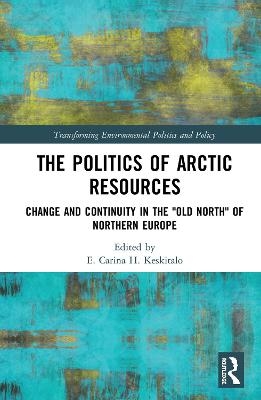
The Politics of Arctic Resources
Routledge (Verlag)
978-1-138-04060-1 (ISBN)
The Arctic has often been seen as a natural area, or even a “wilderness”, where mainly indigenous and subsistence activities have been prominent. Contrary to this, the present volume highlights the very long historical development of resource use systems in northern Europe, across multiple actors and multiple levels, and including varying population groups.
The book takes a past-present-future perspective that illustrates the paths to institutional emergence, change or persistence over time. It also illustrates how institutions may themselves drive changes, through a focus on resource use cases in northern Europe. This volume demonstrates that understanding “northern” issues is less about understanding sets of geophysical, climatological or environmental conditions than about understanding social and institutional structures. Understanding these trajectories into the future is seen as a key way of understanding what responses to future change may be likely and what the institutions are that will shape, limit or enable our responses to climate change.
This book will be of great use to scholars and graduates in the fields of Arctic and northern-region politics, and to researchers of resource use and climate change with a focus on vulnerability, social vulnerability, adaptation and mitigation.
E. Carina H. Keskitalo is Professor of Political Science at the Department of Geography and Economic History, Umeå University, Sweden. She is the editor or author of eight books and one special issue, as well as the author of more than a hundred peer-reviewed scientific articles and book chapters. Her work has focused on the politics of the development of the Arctic as an international region, and on environmental policy and climate change adaptation in a comparative context. She is a contributing author to the 2014 IPCC report, to the second Arctic Human Development Report, and a member of the Group of Chief Scientific Advisors to the European Commission as well as the Swedish expert council on adaptation to climate change. She is also the research coordinator for Sweden's first Arctic social sciences and humanities research programme, the Mistra Arctic Sustainable Development programme, within which this book was produced.
Chapter 1: Introduction. Understanding historical contingencies into the future: cases from northern Europe Chapter 2: Hot-spots and spaces in-between – Development and settlement in the ‘Old North’ Chapter 3: State and Resources in the North: From territorial assertion to the ‘smorgasbord state’ Chapter 4: The institutionalization of forestry as a primary land use in Sweden Chapter 5: Constructing northern Fennoscandia as a mining region Chapter 6: Making "Wilderness" in a Northern Natural Resource Periphery: On Restructuring and the Production of a Pleasure Periphery in Northern Sweden Chapter 7: Ethnic Identity and Resource Rights in Sweden Chapter 8: Energy Regimes in the Fennoscandian north, c1900-2015 Chapter 9: Oil and gas extraction in the Barents Sea: A Nordic state-industry governance system goes north Chapter 10: Troubling the Northern Seas: The Turbulent History of Norwegian and Russian Fisheries Chapter 11: Imageries and historical change in the European Russian Arctic Chapter 12: Regional futures nested in global structures Chapter 13: Conclusion: The "Old Arctic" – or quite simply the developed northern Europe
| Erscheinungsdatum | 30.07.2019 |
|---|---|
| Reihe/Serie | Transforming Environmental Politics and Policy |
| Zusatzinfo | 4 Tables, black and white; 7 Line drawings, black and white; 3 Halftones, black and white; 10 Illustrations, black and white |
| Verlagsort | London |
| Sprache | englisch |
| Maße | 156 x 234 mm |
| Gewicht | 548 g |
| Themenwelt | Naturwissenschaften ► Biologie ► Ökologie / Naturschutz |
| Sozialwissenschaften ► Politik / Verwaltung | |
| ISBN-10 | 1-138-04060-6 / 1138040606 |
| ISBN-13 | 978-1-138-04060-1 / 9781138040601 |
| Zustand | Neuware |
| Haben Sie eine Frage zum Produkt? |
aus dem Bereich


